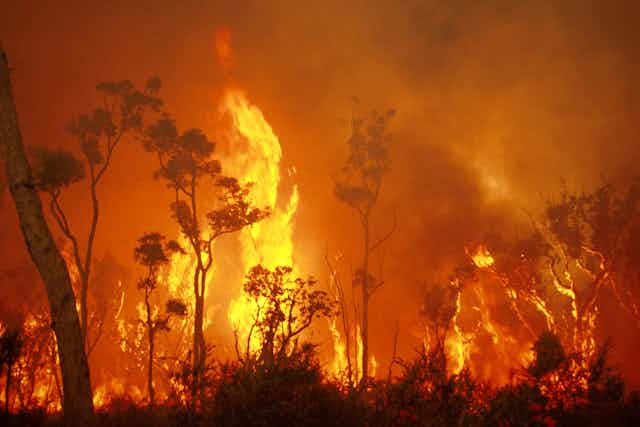Bushfires are highly chaotic natural events, dangerous to people and homes in their path and even more dangerous to those brave enough to fight them.
Australia is all-too-familiar with tragedy caused by bushfire, with days such as Ash Wednesday and Black Saturday ingrained into public and personal memories. The costs in a bad bushfire season can run into billions of dollars, although nothing can truly account for the lives and communities affected by these events.
Bushfires are hard to predict for two reasons. No-one can be sure where or when they will start, although well-educated guesses can be made.
Weather conditions conducive to the outbreak of bushfires are well known and serve to prompt total fire bans to reduce the chance of accidental ignitions. Unfortunately, some of the most frequent causes – lightning strikes and arson – are inherently unpredictable.
Once a bushfire has started it is also difficult to predict precisely where it will go.
While all bushfires do follow well understood physical laws, fine scale variations in factors such as the weather, topography and distribution of fuel mean that a bushfire may appear to behave erratically.
Sudden shifts in the wind direction may cause a quiescent flank to burst to life, creating a new wider fire front. A single tree next to a road or river may enable the fire to jump across an otherwise impassable barrier.
Fighting and controlling fires is a major difficulty for emergency services due to this level of uncertainty. Even deciding the best evacuation routes in uncertain fire conditions can be challenging.
Studying bushfire behaviour
This apparent unpredictability has not deterred fire scientists. Since the early part of the last century these scientists have been carefully studying the behaviour and spread of fires in different conditions.
The results have been collected and tabulated into mathematical formulae to predict how fast a fire will spread. These have been used in Australia for many years for early warning and planning purposes.
But the speed of a fire depends on a wide range of factors. These range from large scale effects, such as the weather or slope of the land, to the small scale, such as whether the fire is burning through leaf litter or grass. The resulting mathematical calculations are complicated, as all of these factors must be included.
Fire science, like many other science disciplines, has benefited from the recent growth in computer processing and data storage. These advances mean meteorological models can now give weather forecasts at very fine scales.
Improvements in computer algorithms have led to newer, more powerful, models to represent spreading fires. Growth in data storage has allowed the creation of detailed maps of terrain and vegetation.
Spark: a new insight into bushfire spread simulation
Fire spread simulation is an intersection of a number of disciplines including ecology, geography, physics, meteorology, mathematics and computer science. When simulating fires, each of these must work together.
To do this most effectively, a new way to bring all of these parts together was needed. This led to the creation of a new software system called Spark.

Spark is a bushfire prediction framework containing all the parts needed to process fine-scale weather and fuel data, run advanced fire simulations and depict the results. The system will be released today at the Australia New Zealand Disaster Management Conference on the Gold Coast.
The parts that make up Spark can also be connected together in whichever way best suits the user. This also has the advantage that as new models come along, the older parts in the system can simply be replaced.
The system enables scientists from multiple disciplines to collaborate. Currently, fire scientists are working to improve fire behaviour models, computer scientists are building new ways to simulate perimeter propagation and software engineers are developing the system on the latest computational hardware.
Spark has been built with the uncertainty of fire behaviour foremost in mind. For predictions of ongoing fires, multiple different cases can be run for slightly different weather forecasts.
The system contains statistical components that allow the results to be combined into maps of the likelihood of when the fire is going to arrive at a given location.

Other current research involves improving fire predictions by using a range of conditions, some likely and others very unlikely.
These predictions can be combined with real-world measurements of the fire using a statistical method to feed back into the model. This allows the model to respond to changing conditions, including highly unlikely events, providing better predictions of future fire behaviour.
Bringing the latest fire science to the fireground
The collaborative approach behind Spark means that services and agencies using the system will benefit from the latest advances in fire science.
The system can be fully customised and can be integrated with existing systems. Spark can also be built into any number of applications, such as evacuation planning or fire regime tools.
Spark can also be used for land management and planning, fire mitigation analysis, real-time fire prediction, risk analysis or reconstruction and analysis of fire events.

